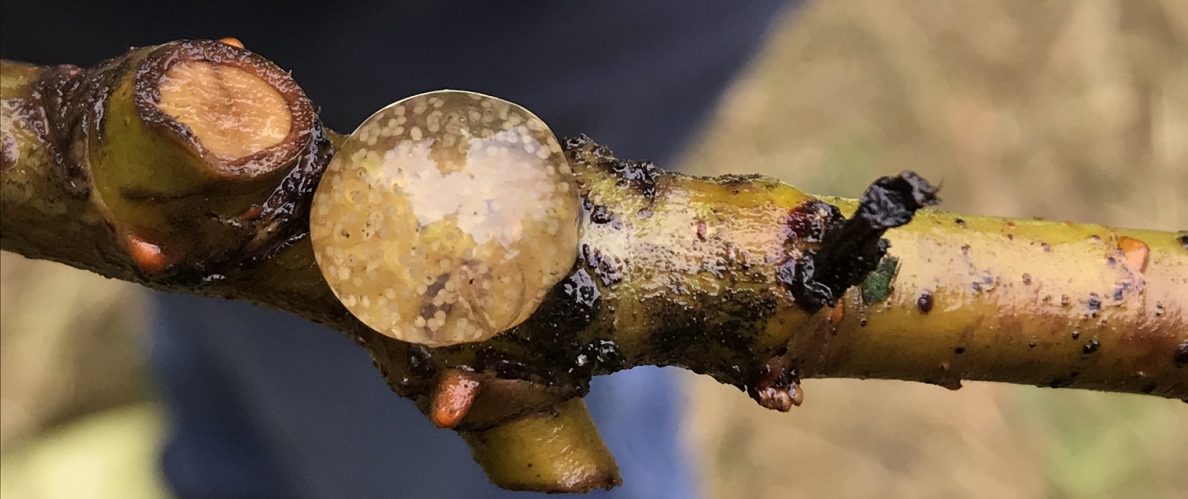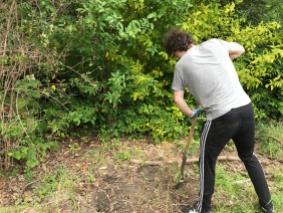
The students from the University of Washington’s Introduction to Environmental Science class have become a major part of our GreenFriends Greenbelt Restoration project. They are required to have three hours of volunteer work and the course’s teaching assistants have been happy to send out the registration links for our work parties.
Their volunteer reports are usually due the sixth week of the quarter so there may be a long gap between the last work party of a quarter and the first one of the following quarter. I really miss working with the students during that time. I find it interesting that early in my work life (when I was 26 y.o.), I taught nursing students from the University of Washington, and here I am at the end of my work life (soon to be 70 y.o.) teaching UW students once again.
One of the reasons I enjoy working with them is that they may not have spent much time in nature and almost none have done this kind of work before. I love witnessing their growing enthusiasm as they work together to transform the land.
A student sent me an email after our last work party. He said:
Thank you for giving me a chance to actually get out of my college residence hall and gain first hand experience on working at eco-friendly environment. As an international student who is from Seoul, Korea, who has spent all of his life living in city regions, it was amazing to get some eco-friend work done at eco-friendly environment.
I think their participation in this project is as important to them as they are to me.
The June 22 work party was held during the first week of UW’s Summer Quarter. I had never offered one that early in the quarter before, so I didn’t know how many students would come. I was delighted when 10 college students, 2 high school students and an adult who has helped with forest restoration work parties in other Seattle parklands showed up.
This work party was devoted to removing the invasive vines and plants that have been emerging throughout our Greenbelt site. One of the invasive plants that abound at this time of year is bindweed (aka morning glory). Bindweed vines wind around healthy plants and essentially strangle them. I’ve been told that bindweed roots can go 32 feet into the ground, so it’s not a feasible goal to eliminate the plant completely. If we can dig out at least some of the root, though, it will weaken the vine and slow down its growth.
I took these photos of bindweed that covered a thimbleberry plant on our site last year. I’m happy to report that much less bindweed came up near that shrub this year.
If you click on any of the photo galleries you will see enlarged copies of the photos.
After listening to an initial orientation, the volunteers divided into three teams. Team One focused on removing bindweed from the northwest part of the property. It is painstaking work to remove the vine in a way that doesn’t destroy the leaves on the native plant that is being freed. This group worked diligently and carried many loads of bindweed to the area where we dry out the invasive plants, so they don’t re-root. [Note #1 The plant you see above the young man in the first photo below is knotweed. That is also an invasive plant but is one that Seattle Parks Department staff removes.]
The invasive plant that Team Two focused on removing is known as creeping buttercup. This team worked in a section of the property that hadn’t been cleared before. I had thought it might be pulled out easily, but that was not the case; the roots were firmly entrenched. The removal was also hampered by the fact that the ground is much harder in the summer; it can be difficult to even get a shovel into the dirt. I was excited to see the bare ground becoming visible as the work progressed.
Team Three focused on removing blackberry vines. For the most part, the blackberry plants were small, but there were a lot of them, especially on the paths.
After a break, all of the team members joined together in working on the western border of the Greenbelt site that is just north of ours. They continued the process of clearing an area that my neighbor John and I had started in early May. After the weeds were removed, work party participants spread burlap bags on the land and then poured wood chip mulch on top of the bags. The burlap and the mulch will reduce weed growth and keep the soil moist.
Once again, the effort of a small group of volunteers made such a tangible difference. And they accomplished all of this during a work party that lasted only three hours. Together we are restoring land that was covered by invasive blackberry, bindweed and ivy vines for more than 50 years. It is back on the road to once again becoming a healthy forest.

























Thank you Karuna, for all this work. I know you love it but it is still hard work that benefits us all!
LikeLiked by 2 people
Thanks Kathie.
LikeLiked by 1 person
I agree! Well done, I am sure Amma would be proud of all the work you all are getting done!
LikeLiked by 1 person
I’m smiling. Thanks.
LikeLike